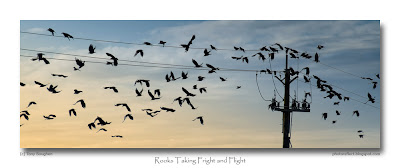 click photo to enlarge
click photo to enlargeI recall that on at least one occasion during my childhood the gun club in the market town where I lived took their weapons at the beginning of April and blasted the nests in a nearby rookery. Twigs, adults and young birds were destroyed by the co-ordinated fire of multiple shot guns. Quite what was achieved by this I don't know, but it seemed to satisfy the blood-lust of those involved.
Like most large, black birds the rook (Corvus frugilegus) has something of a bad name. Yes, it can eat newly planted seed, grazes on young plants, and sometimes joins the carrion crow (Corvus corone) in feeding on dead wild and farm animals. But, it also makes great inroads into invertebrates that are destructive to plant life, and deals very effectively with plagues of caterpillars. So it is by no means clear that it has an entirely negative effect on arable farms here in Lincolnshire or elsewhere. Nonetheless, the irregular persecution of rooks continues, sometimes by illegal means.
Perhaps if people knew more of the habits of the rook they might view it in a different light. The species is highly gregarious (just like people), and is thought to be mainly monogamous, often having the same mate for life (also like us!) In the UK it tends to be a home bird, rarely moving more than 60 miles or so from the place it was born, though rooks from Northern Europe do migrate south and west for the winter, swelling the populations of the countries where the weather is milder. It is a colonial breeder, favouring the very tops of tall trees that are located in clumps. My village, very typically for England, has a rookery in the tallest trees of the churchyard. People have long ascribed to the rook intelligence greater than that found in most birds, and have often described an apparently organised meeting of them on the ground as a "parliament." Recent research has proved that it's no bird-brain, showing that in some circumstances it is capable of finding and using tools to secure its food, something that is not observed in other species.
On a recent evening walk we came upon a couple of hundred rooks strung out along some wires. I took a photograph of the birds sitting there in serried ranks. However, as we rounded a line of trees they decided we were too close for comfort and in their fright took flight. The cropped image above shows a small group of the much larger total as they swirled and tumbled off the wires and caught the wind that carried them to a safe distance from us.
photograph & text (c) T. Boughen
Camera: Olympus E510
Mode: Aperture Priority
Focal Length: 110mm (220mm/35mm equiv.)
F No: f7.1
Shutter Speed: 1/2000 seconds
ISO: 100
Exposure Compensation: -0.7 EV
Image Stabilisation: On